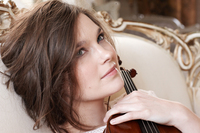London Philharmonic makes magic at Hill Auditorium concert

Janine Jansen
That’s what the top-notch London Philharmonic Orchestra, directed by Principal Conductor Vladimir Jurowski, offered Tuesday evening at Hill Auditorium, in a thrilling concert presented by the University Musical Society.
The concert featured two novelties, one contemporary—Mathias Pinscher’s “Towards Osiris”—and one late-19th century—Tchaikovsky’s rarely heard “Manfred Symphony;” and an 18th century gem, Mozart’s Violin Concerto No. 5, with the Dutch violinist Janine Jansen as soloist.
Both repertoire and playing were richly rewarding throughout the evening, and the program seemed designed to keep the ear fresh, a pleasure in itself.
Jansen was the evening’s star—if it wasn’t the orchestra itself—but in a concert that built to a spectacular conclusion with the nearly hour-long “Manfred,” it somehow seems right to talk about what was last first.
That actually would not be “Manfred” but the Tchaikovsky encore the orchestra offered—the Grand Pas de Deux from “Nutcracker.” The piece, so familiar, is a sort of retroactive bellwether for “Manfred,” which few of us can claim to know half so well (or to have heard live, ever). Played so swirlingly and darkly, its lines spilling forward, making the most of the music’s lyrical momentum, the “Nutcracker” excerpt was not merely gorgeous (and visual for those who can see every fish dive of the pas de deux); it told you to trust that the less-familiar “Manfred” was probably as brilliantly played as it seemed.
“Manfred” is huge in all its aspects—its heroic program, taken largely from Lord Byron’s poem; its length; and its strength. For brass parts strong as fortress walls, earth-shaking drum rolls and organ chorales that the heavens (and orchestras) stop for, “Manfred” is your symphony. There’s delicacy here, too—witness the scherzo, with its scintillating flashes of light—and lyricism, too, along with rusticity, in the Pastorale.
It’s all magnificent, and so were the LPO players, making the most of the work’s colors and the hero’s pain and passion. Jurowski raised them, soloist by soloist, section by section (brass and winds justly first), for our applause. Jurowski’s pacing within the movements was superb; but the work’s grand architecture was as satisfying as the rooms he created.
“Manfred” calls for a huge orchestra. Mozart calls for a small one. And that’s what there was on stage for the concerto with Jansen. Here, the striking quality in the orchestral playing was lightness and clarity and the beautiful shaping of every phrase—whether it was accompanying gesture or main melodic material.
The orchestra, and Jurowski, were ever in contact with Jansen, who herself seemed to play as much to the orchestra as to the audience. Nothing was lost by virtue of that; on the contrary, the gain was felt on our side of the footlights: a sense of intimacy, without loss of projection, and a sense of real duet playing between orchestra and soloist.
But most striking about Jansen’s playing, perhaps, was its fine-boned structure. It had great charm and wit—and grit when necessary, as in the “Turkish” finale; it also had warmth and fluency (all those great entrances without a sharp point of attack). But throughout it retained an almost porcelain quality that was tremendously appealing.
Small was beautiful in the Mozart, but big was the bonanza in the evening’s opening work, Pinscher’s “Towards Osiris.” Like “Manfred,” it was a great reminder of what a great orchestra can do. Here, the task was creating an eerie soundscape—can someone please write the movie to go with this score?—that took full advantage of the sonic capabilities of every section of the orchestra. It was a brief journey filled with brayings and scrapings, silvery chromatic string climbs and playful zings from the brass that all led to an explosion of percussion and sirens—sheer chaos that wore itself out in a violin trill and a clack of a wooden block.
Getting to journey’s end was all the fun. But so was getting to all the evening’s destinations.


Comments
Erich Jensen
Thu, Dec 8, 2011 : 2:41 p.m.
This well written review captures this patron's sentiments and experience of that evening exactly!
Ron Granger
Wed, Dec 7, 2011 : 4:53 p.m.
I knew that would be a great performance. I wish I could have been there. Ann Arbor is so incredibly fortunate for the amazing performances that UMS manages to bring to our very amazing venues. These performances make the long Winter something to look forward to. In larger cities, the competition for seating is much more extreme, with large blocks of seats tied up by corporate donors, and connected individuals. Ticket prices are often much higher. This is the sort of critically important culture and art that attracts talent to our town. That talent is essential in enabling businesses to start here, relocate here, and remain here. Thanks to everyone involved in these UMS productions!